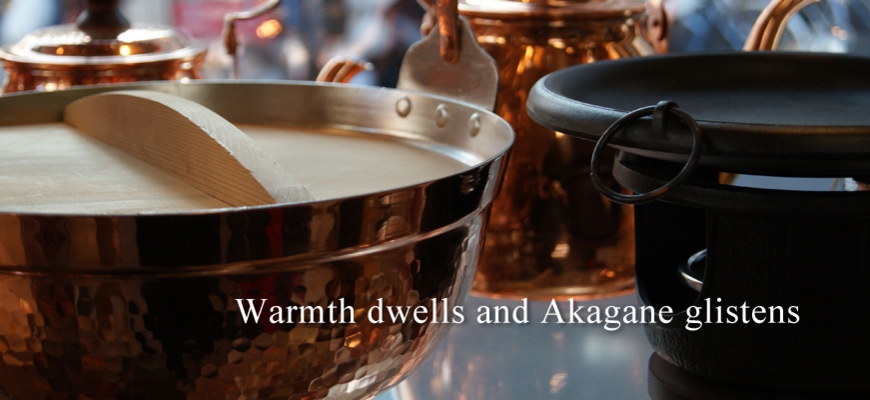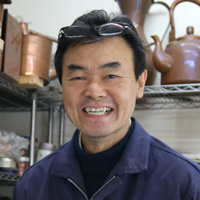
Tamotsu Hoshino
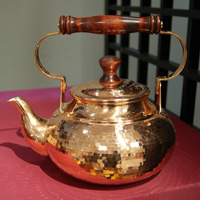
A technique called tsuchimeuchi creates the warmth of handwork.
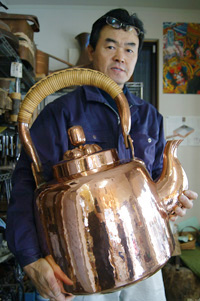
A kettle made by Hoshino and his father.
What is a copperware?
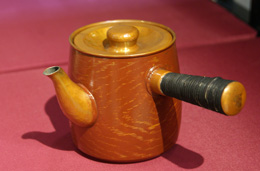
Copperware have always been used daily from old times. Today, Toyama and Niigata are also famous for their own techniques, but this unique technique called boil-coloring can be said as a distinctive one of Edo.
About the store name
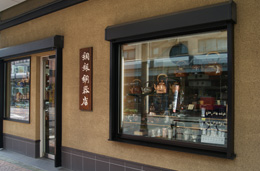
We do make some silverware, but doh-gin (copper-silver, the name of the store) was named after my grandfather, Ginjiro. Back then, there were many people who come here thinking that we also make silverware.
As a craftsman of copper ware
Could you tell me about how you became a craftsman?
I do not have a specific trigger, but when I was little, I grew up seeing my grandfather and my father work. I used to play at the work place, and it was natural for me to take this job.
Could you tell me when you became a full-fledged craftsman after starting your training at 18?
I am still not sure, but I think I recently just became one.
Do you think your aim is set high because of the experience working with your predecessor?
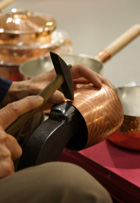
About copper ware
Could you tell me about the products you make today?
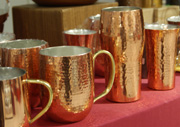
Have the things you make changed compared to the past?
We call the fireplace for hibachi, an “Otoshi”, and we used to make only these back then. I sometimes receive orders today. Now, the main material is veneer, but they used to send us measurements for paulownia wood (kiri), called “Kiri-sun”. They used to have these fireplaces at restaurants for each person, but when gas came out, this custom died. We get orders from joineries, but because we do the production with hands, the number of pieces produced is never high. My father always told me that we have to do our best since people are waiting for us even until midnights.
It seems that the demand back then was very different from today.
Yes. Until gas became popular, there used to be many pots and fireplaces. There was a time when only “kando-ko” was made. It is a copper pot which is used to warm sake. There is also a pot called “unagi do-ko” where you heat sake using the heat of the fire burning unagi. These kando-ko too were taken over by machine-made stainless steel pots. After stopping the production of kando-ko, I think the production of small works such as bowls and omelet pans started. In the old times, craftsmen had some extra time in summer since their work of making kando-ko is not that busy. They started making these small products at these times and it gradually became fully promoted. At my father’s times, teapots were the main product. We used to put these teapots at department stores in Shinjuku, and about 50 of them were sold each month.We used to have two craftsmen who only make teapots here. Also, we had a craftsman from Niigata who did the lacquering all year round.
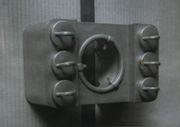
“Kando-ko” is a copper pot which is used to warm sake(the image provided by Tamotsu Hoshino)
Could you tell me about any particular features of copper?
Copper is a type of metal which is very easily heated. It can warm water fast and the heat does not concentrate only on the part where the fire is. Stainless steel does not spread the heat, which makes it burn. This is why omelet pans are best with copper.In addition, at Japanese sweets shops, they use copper pots to cook adzuki beans. Because the heat is conducted uniformly, it is able to cook the beans evenly and beautifully.
Are there many copperware craftsmen in Taito city?
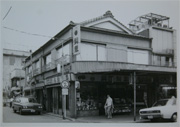
There were many iron foundries around here, which made it easy to supply materials. Also, there were many teahouses where geishas gathered too, so there were always demands. Moreover, this street had many theaters and was always crowded. When I was in elementary school, the store was opened until 10 o’clock at night. Back then, Asakusa was very famous for movies, but there are none today.
Former store before rebuilding(the image provided by Tamotsu Hoshino)
About the production process
Could you tell me about the production process?
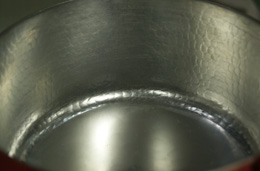
A technique called “tsuchimeuchi" creates the hammer pattern inside of a ware.
Could you tell me about the coloring process?

Small pot finishing sulfide
It’s because of copper that they have such many colors.
Nowadays, people associate luminous things with copper but not with orange colored products. It is a little troublesome for us, makers. We start to lose the intention of why we spend so much time on it. This is why many craftsmen make their products shiny and glittering. However, I think products used at tatami rooms should be moderate and should have calm color.
Tools
Could you tell me about the tools used?
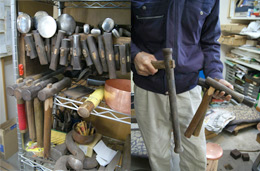
Possibility of hand-made
Could you tell me about the quality of hand-made?
With machines, there will not be elegance. All of the hammer perforations would be the same. After all, hand-made would leave an impressive remark.
Could you tell me about the things you keep in mind as a craftsman?
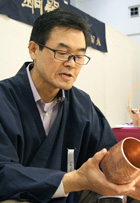

Tamotsu Hoshino

A technique called tsuchimeuchi creates the warmth of handwork.

A kettle made by Hoshino and his father.
What is a copperware?

Boil-colored teapot
Copperware have always been used daily from old times. Today, Toyama and Niigata are also famous for their own techniques, but this unique technique called boil-coloring can be said as a distinctive one of Edo.
About the store name

We do make some silverware, but doh-gin (copper-silver, the name of the store) was named after my grandfather, Ginjiro. Back then, there were many people who come here thinking that we also make silverware.






